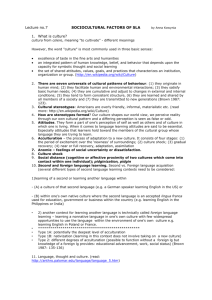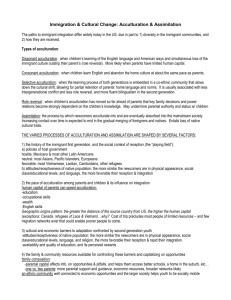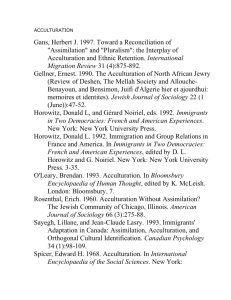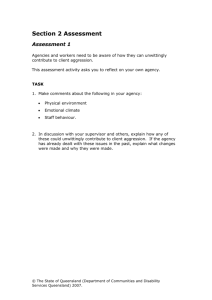Section 1 activities - QCOSS Community Door eTraining
advertisement
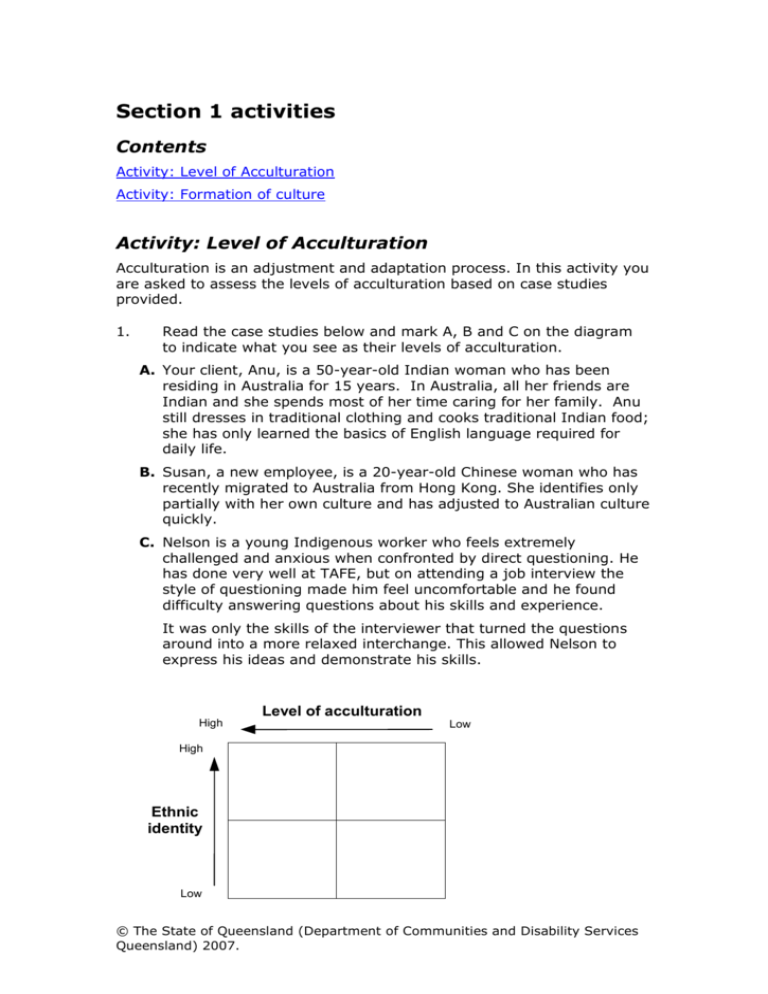
Section 1 activities Contents Activity: Level of Acculturation Activity: Formation of culture Activity: Level of Acculturation Acculturation is an adjustment and adaptation process. In this activity you are asked to assess the levels of acculturation based on case studies provided. 1. Read the case studies below and mark A, B and C on the diagram to indicate what you see as their levels of acculturation. A. Your client, Anu, is a 50-year-old Indian woman who has been residing in Australia for 15 years. In Australia, all her friends are Indian and she spends most of her time caring for her family. Anu still dresses in traditional clothing and cooks traditional Indian food; she has only learned the basics of English language required for daily life. B. Susan, a new employee, is a 20-year-old Chinese woman who has recently migrated to Australia from Hong Kong. She identifies only partially with her own culture and has adjusted to Australian culture quickly. C. Nelson is a young Indigenous worker who feels extremely challenged and anxious when confronted by direct questioning. He has done very well at TAFE, but on attending a job interview the style of questioning made him feel uncomfortable and he found difficulty answering questions about his skills and experience. It was only the skills of the interviewer that turned the questions around into a more relaxed interchange. This allowed Nelson to express his ideas and demonstrate his skills. Level of acculturation High Low High Ethnic identity Low © The State of Queensland (Department of Communities and Disability Services Queensland) 2007. 2. Give some examples of how the level of acculturation might affect your working relationships. A. Anu .................................................................................... .................................................................................... B. Susan .................................................................................... .................................................................................... C. Nelson .................................................................................... .................................................................................... Feedback to Activity: Level of acculturation 1. Levels of acculturation: Level of acculturation High Low High A Ethnic identity Low B C 2. Examples may include: A. You will need to ensure Anu understands the processes involved in the service you are providing. It may be necessary to provide information printed in an appropriate language or engage an interpreter. B. Susan’s level of acculturation suggests that she is likely to prefer to be treated in the Australian way rather than the traditional Chinese manner. C. Nelson’s discomfort with direct questioning suggests that he identifies strongly with his Indigenous culture. The interviewer needs to acknowledge the cultural difference and adjust her questioning style. © The State of Queensland (Department of Communities and Disability Services Queensland) 2007. It is important that you take questioning techniques and other interview processes into account. This is especially important where people from other cultural backgrounds or people with a disability are concerned. Activity: Formation of culture What factors contribute to the formation of your culture? In this activity you will explore some of the values or behaviours of your family or social group. Factors that contribute to formation of culture: Internal factors External factors • • Values and beliefs ─ provide guidance to our attitudes, perceptions and judgement Norms ─ provide guidelines towards culturally acceptable behaviour or expected behaviour • Thinking style ─ how information is processed • Problem-solving style – problem analysis and identifying solutions • Art and craft • Customs ─ dressing style, forms of address and relating to others • Dietary habits • Law system ─ social rules, standards and regulations • Communication style ─ language, non-verbal communication and interpretation of meaning • Family structure ─ kinship and Family loyalties and role expectations responsibilities (Modified from Marsella and Westermeyer, 1993) • 1. Give at least one example of cultural values or behaviours typical in your family or social group, for example, how you greet people, celebrate events, religious observances etc. 2. Are these values or behaviours shared by other families or social groups that you know? What do you think may be the reason for differences or similarities? 3. Could demonstrating these values or behaviours cause misunderstanding or friction in the workplace? Feedback: You may have given an example like this. 1. Members of my family always greet each other with a kiss on both cheeks - it is the norm in the part of Italy where we are from. 2. Some of our non-Italian friends do it when they visit our home – it’s like they have adapted to our culture. © The State of Queensland (Department of Communities and Disability Services Queensland) 2007. 3. As my co-workers are not of Italian heritage, I think they would be very uncomfortable if I greeted them this way. © The State of Queensland (Department of Communities and Disability Services Queensland) 2007.

